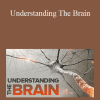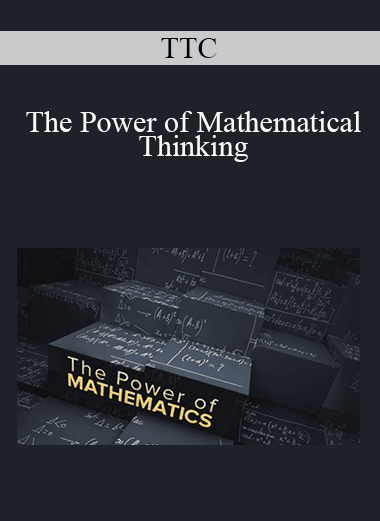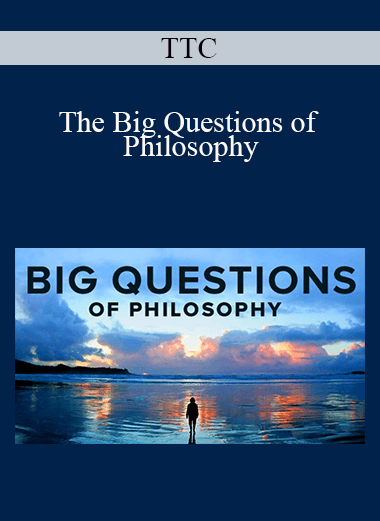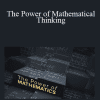TTC – The Power of Mathematical Thinking
$214.95 Original price was: $214.95.$53.00Current price is: $53.00.
Digital Download: You will receive a download link via your order email after successful payment.
Format: [24 Videos(AVI) + 1(PDF) + 2 (mhtml) ] | 5.060 GB
Scientists studying the universe at all scales often marvel at the seemingly “unreasonable effectiveness” of mathematics—its uncanny ability to reveal the hidden order behind the most complex of nature’s phenomena. They are not alone: Economists, sociologists, political scientists, and many other specialists have also experienced the wonder of math’s muscle power.
This use of mathematics to solve problems in a wide range of disciplines is called applied mathematics, and it is a far cry from the impression that many people have of math as an abstract field that has no relevance to the real world. Consider the remarkable utility of the following ideas:
- The n-body problem: Beginning with Isaac Newton, the attempts to predict how a group of objects behave under the influence of gravity have led to unexpected insights into a wide range of mathematical and physical phenomena. One outcome is the new field of chaos theory.
- Torus: The properties of a donut shape called a torus shed light on everything from the orbits of the planets to the business cycle, and they also explain how the brain reads emotions, how color vision works, and the apportionment scheme in the U.S. Congress.
- Arrow’s impossibility theorem: In an election involving three or more candidates, several crucial criteria for making the vote equitable cannot all be met, implying that no voting rule is fair. This surprising result has had widespread application in the theory of social choice and beyond.
- Higher dimensions: Whenever multiple variables come into play, a problem may benefit by exploring it in higher dimensions. With a host of applications, higher dimensions are nonetheless difficult to envision—although Salvador Dali came close in some of his paintings.
Math’s very abstraction is the secret of its power to strip away inessentials and get at the heart of a problem, giving deep insight into situations that may not even seem like math problems—such as how to present a winning proposal to a committee or to understand the dynamical interactions of street gangs. Given this astonishing versatility, mathematics is truly one of the greatest tools ever developed for unlocking mysteries.
In 24 intensively illustrated half-hour lectures, The Power of Mathematical Thinking: From Newton’s Laws to Elections and the Economy gives you vivid lessons in the extraordinary reach of applied mathematics. Your professor is noted mathematician Donald G. Saari of the University of California, Irvine—a member of the prestigious National Academy of Sciences, an award-winning teacher, and an exuberantly curious investigator, legendary among his colleagues for his wide range of mathematical interests.
Inviting you to explore a rich selection of those interests, The Power of Mathematical Thinking is not a traditional course in applied mathematics or problem solving but is instead an opportunity to experience firsthand from a leading practitioner how mathematical thinking can open doors and operate powerfully across multiple fields. Designed to take you down new pathways of reasoning no matter what your background in mathematics, these lectures show you the creative mind of a mathematician at work—zeroing in on a problem, probing it from a mathematical point of view, and often reaching surprising conclusions.
When Elections Go Haywire
Professor Saari is a pioneer in the application of mathematics to problems in astronomy, economics, and other fields, but he is best known to the general public for his influential critique of election rules. In this course, he devotes several lectures to what can go wrong with elections, showing how the least preferred contender in a race with three or more candidates can sometimes end up as the winner—and how this flaw is latent in many apparently fair voting methods. He also shows that similar problems plague other ranking procedures, such as the method of apportioning congressional seats in the U.S. Congress. Among the many cases you explore are these:
- Suppose your local school ranks students by the number of A’s they receive. It sounds like a formula for excellence, but what it means is that the student who gets an A in one course and F’s in everything else will be ranked above the student who gets all B’s. The same flaw is at the heart of plurality voting.
- What would you think if a consultant approached your organization and offered to write a fair voting rule that guaranteed whatever outcome you wanted in a vote involving several alternatives? Such consultants may not exist, but their methods do and are in wide use when making paired comparisons.
- You are on a search committee whose members have voted on four candidates. Before you announce the winner, the lowest vote-getter drops out. Should the committee take a new vote? If it doesn’t, the original choice may not represent the true preferences of the members.
- Your state is entitled to a number of seats in the U.S. House of Representatives proportional to its population. Should you object if the total number of seats in the House is increased? In fact, your state could lose a seat under this scenario, as Alabama did in 1880.
Apart from the fascination of studying such examples, you invariably get the big picture from Professor Saari, as he shows how the power of mathematics comes from reaching beyond, say, a particular election to consider what can possibly happen in any election. And he introduces a set of mathematical ideas that prove remarkably useful at analyzing a wide range of problems at a deep level.
A Mathematical Odyssey
Both entertaining and intellectually exhilarating, this course is based on Professor Saari’s own mathematical odyssey—from his early career in celestial mechanics to his discovery that the social sciences are fertile ground for sophisticated applied mathematics. Furthermore, Dr. Saari has delightfully contrarian impulses that make him question why something is true, or, indeed, if it is true at all. In this spirit, you examine Newton’s theory of gravitation, Arrow’s impossibility theorem, Adam Smith’s “invisible hand” concept, and other ideas, pushing beyond the standard interpretations to extract new insights that in many cases represent original contributions by Dr. Saari.
By his enthusiastic example, Professor Saari shows that the abstract nature of mathematics is nothing to fear. Instead, it is something to cherish, nurture, and use with imagination. “In mathematics, we have the ability to transcend our experiences,” he says. “We do not want to solve the problems of the past; we want to solve problems that we’ve never experienced or didn’t anticipate.” And for that, we need The Power of Mathematical Thinking.
Get Download TTC – The Power of Mathematical Thinking at IMC.sale today!
Delivery Method
– After your purchase, you’ll see a View your orders link which goes to the Downloads page. Here, you can download all the files associated with your order.
– Downloads are available once your payment is confirmed, we’ll also send you a download notification email separate from any transaction notification emails you receive from IMC.sale.
– Since it is a digital copy, our suggestion is to download and save it to your hard drive. In case the link is broken for any reason, please contact us and we will resend the new download link.
– If you cannot find the download link, please don’t worry about that. We will update and notify you as soon as possible at 8:00 AM – 8:00 PM (UTC+8).
Thank You For Shopping With Us!
Be the first to review “TTC – The Power of Mathematical Thinking” Cancel reply
Related Products
Everything Else
Medical & Health
Everything Else
Medical & Health
TTC – Outsmart Yourself: Brain-Based Strategies to a Better You
Psychology & Body Language
Psychology & Body Language
Psychology & Body Language
Psychology & Body Language













8 reviews for TTC – The Power of Mathematical Thinking
There are no reviews yet.